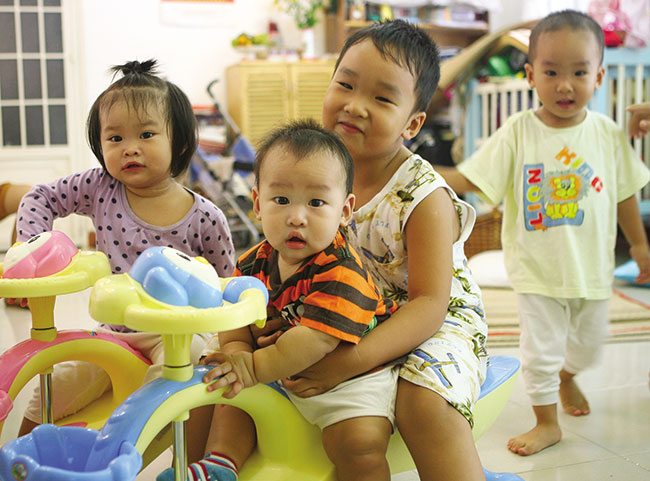Balancing the gender gap

Vietnam is facing calls to address its gender inequality issues
According to the United Nations Population Fund (UNFPA), the sex ratio at birth (SRB) imbalance has become more serious in Vietnam. It has increased from a ratio of 106.2 boys per 100 girls in 2000 to 113.8 boys per 100 girls in 2013. The trend is set to continue in the coming years.
Together with India and China, the SRB imbalance has remained a matter of special concern for years in both the urban and rural areas of Vietnam, although it is not a new issue.
“Like China, which has been suffering grave consequences due to SRB imbalance, as its men were struggling to find women to marry, Vietnam’s imbalanced SRB results from the year-long policy on small-scale family and traditional culture, where most families want a son to maintain lineage and worship ancestors. Moreover, together with around 70 per cent of the population in rural areas do not have social insurance, the male kinship system causes people to look for sons to secure them in their old age,” explained Phan Thi Thu Hien, programme specialist and gender team leader at the UNFPA.
According to the specialist, the heart of the SRB imbalance issue is not sex selection, but inequality and different gender values. Gender-biased sex selection is exacerbated by patriarchal family values, amplified in particular by the male-oriented kinship system, as well as a lack of social and economic autonomy for women. Therefore, the solution is not to focus on the phenomena, but to address the broader context of socio-economic development and the promotion of human rights to dismantle gender inequality, so that the dignity and rights of every woman, young person, and individual are protected.
Hien went on to say that Vietnam was still very focused on the prevention of the problem, but not yet ready to respond to the consequences that SRB imbalance may cause in the near future.
This imbalance sets off a series of falling dominos with grave consequences for everyone - women, men, families, and entire communities. Vietnam is no exception, as less young women means that many more men will be unable to marry, causing a potential rise in forced marriages and human trafficking. Pent up male frustration could fuel social unrest, domestic violence, and the trend of migration for the sole purpose of marrying, which could result in more social and, ultimately, economic instability back home, Hien warned.
According to the UNFPA, Vietnam’s current social protection system, focused on formal sector workers, fails to cover the informal sector. The government pension scheme suffers from inequalities in age, gender, and economic status, and social allowance schemes target only the elderly at the very end of their lives. To date, social protection schemes cover only half of the elderly population.
Moreover, old thoughts remain unchanged, while propaganda programmes aimed at promoting gender equality and raising awareness about the issue have proved less effective.
“It took 20 years for South Korea to successfully balance the SRB. The key to this success is balancing fast economic growth with a good social protection and welfare system for older people, and the improvement of general equality. So the question here is, how long will it take Vietnam to address this problem? It might be 50-100 years or more before the sex ratio at birth is balanced without any intervention,” Hien forecast.
Vietnam is slowly losing its women. And if things don’t change, by 2050, Vietnam will face a terrible scenario - men will far outnumber women by 10 per cent or more. In fact, if the imbalanced SRB remains, there will be a surplus if some 2.3 to 4.3 million men, the UNFPA warned.
What the stars mean:
★ Poor ★ ★ Promising ★★★ Good ★★★★ Very good ★★★★★ Exceptional
Latest News
More News
- Hanoi pilots electronic health record solution (November 10, 2024 | 12:25)
- Vietnamese consumer sentiment outperforms regional averages (November 08, 2024 | 18:00)
- Japfa Vietnam serves nutrition to 1,500 children to year-end (November 06, 2024 | 16:32)
- Tan Hiep Phat - three decades of serving society (November 04, 2024 | 17:58)
- Hanoi to restrict polluting vehicles across key districts (November 04, 2024 | 16:29)
- Hoan My Medical Group launches breast cancer screening to support community health (November 02, 2024 | 10:56)
- Vietnamese students explore the future at STEAMese Festival (October 28, 2024 | 16:55)
- Honouring ‘Green Warriors’ on Vietnamese Women’s Day (October 21, 2024 | 15:16)
- Swing for the Kids charity golf tournament kicks off (October 13, 2024 | 09:00)
- Swing for the Kids 2024 tees up opportunities for Vietnam's youth (October 12, 2024 | 10:00)




















 Mobile Version
Mobile Version